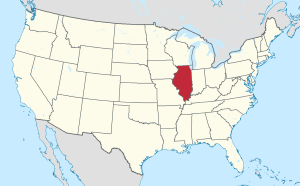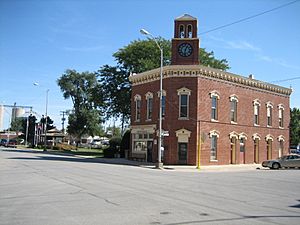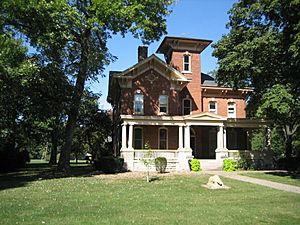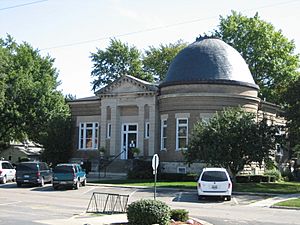Fairbury, Illinois facts for kids
Quick facts for kids
Fairbury
|
|
|---|---|

Downtown Fairbury
|
|

Location of Fairbury in Livingston County, Illinois.
|
|

Location of Illinois in the United States
|
|
| Country | United States |
| State | Illinois |
| County | Livingston |
| Area | |
| • Total | 1.82 sq mi (4.72 km2) |
| • Land | 1.82 sq mi (4.70 km2) |
| • Water | 0.01 sq mi (0.02 km2) |
| Elevation | 686 ft (209 m) |
| Population
(2020)
|
|
| • Total | 3,633 |
| • Density | 2,000.55/sq mi (772.22/km2) |
| Time zone | UTC-6 (CST) |
| • Summer (DST) | UTC-5 (CDT) |
| ZIP Code(s) |
61739
|
| Area code(s) | 815 |
| FIPS code | 17-24764 |
| GNIS feature ID | 2394727 |
| Wikimedia Commons | Fairbury, Illinois |
Fairbury is a small city located in Livingston County, Illinois, United States. In 2020, about 3,633 people lived there.
The city is found along U.S. Route 24. It is about 11 miles east of Chenoa. Fairbury is also six miles west of Forrest. The city was officially started in 1857. Many members of the Apostolic Christian faith live in Fairbury. Their community first settled in the area in 1864.
Contents
Fairbury's Beginnings: How the City Started
Founding of Fairbury in 1857
Fairbury was planned out on November 10, 1857. Two important people, Caleb L. Patton and Octave Chanute, helped create it. Like many towns in Illinois during the 1850s, Fairbury was built around a train depot. It had 26 blocks, each with 14 to 16 lots. There wasn't a main public square at first. One was added later in a part of town called Marsh's addition. The town's layout was very similar to nearby towns like Chatsworth, Illinois, Gridley, and El Paso. These towns were all along the same railroad line.

Octave Chanute was a civil engineer. He worked for the new Peoria and Oquawka Railroad. This railroad is now known as the Toledo, Peoria and Western Railroad. Caleb L. Patton was one of the first people to settle on the land where Fairbury was built. Chanute, who was from France, later became famous for his book Progress in Flying Machines. This book helped a lot with early aviation. The Wright brothers even said Chanute was like a mentor to them. Chanute built the railroad that made Fairbury possible. However, he did this even though Patton, one of Fairbury's first citizens, didn't want it.
Caleb Patton owned the land where the original town was built. He advertised the land for sale, which brought more people to live there. When Patton heard that Chanute wanted to build a railroad nearby, he saw a chance to use his empty land. He made a deal: if Chanute built his railroad through Fairbury, Patton would give Chanute half of the town's property.
Patton and Chanute agreed. Patton gave a small piece of land to the Baptist Church. He also set aside an area for the railroad and a depot. But when Chanute reached Fairbury, he found a group of armed citizens waiting. The town had passed a rule saying no railroad could go through Fairbury. They told Chanute to build around the town instead. They even had a court order from Pontiac, Illinois to stop him. Alma Lewis-James, who wrote a book about early Fairbury, described what Chanute did next:
"...Chanute was clever. He did not use force, but quietly laid his rails to the eastern edge of town, skipped Fairbury, began again at the western edge, and worked straight on until Saturday night. In the darkness and secretly, he moved his crews back; and the next morning, at first dawn; and reinforced by armed guards of his own, he was ready for business. To the consternation of the dumbfounded and helpless villagers, he rushed the track straight through the town and the courthouse was closed. By Monday morning he was well on his way to Peoria."
In 1859, John Marsh bought about 80 acres of land west of Patton's property. He gave a part of his land to the town, and it was named Marsh Park. He named another part of his new area Livingston Square. This area was meant for businesses and markets. He also built the Arcade Block, which was a series of brick buildings connected together. In 1866, the Livingston Hotel was built. It was famous for being the only hotel in Illinois with running water at the time.
Marsh did not like the east side of Fairbury. He worked hard to develop his west side. This caused a rivalry between the two sides of town. After a big fire, many people from the east side went to work on Marsh's west side. This was because there were many job openings there. A new railroad was being planned. Marsh used his influence to make sure it only went through the west side of Fairbury, not the east.
Fires in Fairbury: A Challenging Time
After a fire caused by a train, three more fires happened. These fires destroyed many parts of the town. All of them were near the railroad. Together, they ruined more than 20 buildings and homes. Also, every few nights, someone would try to start a fire in a neighborhood. Sometimes they succeeded. Because of this, Fairbury became known as a town that caught fire easily.

The time of many fires in Fairbury ended after the Livingston Hotel burned down. The two powerful men in town, Marsh and Amsbary, blamed each other for the fire. They both took legal action against each other. Marsh was investigated, but he was found not responsible. The influence these two men had in town quickly faded. The rivalry between the east and west sides of Fairbury also ended. The town stopped its disagreements and decided to work together instead.
A Famous Name Dispute: Ronald McDonald's Restaurant
Fairbury was also the setting for a long-running legal disagreement. A local restaurant owner named Ronald McDonald had a business with his own name. For 26 years, he had a dispute with the large fast-food company McDonald's over the use of the name. In the end, he was allowed to keep using his name for his restaurant.
Fairbury's Location and Size
Based on the 2010 census, Fairbury covers a total area of about 1.8 square miles (4.7 square kilometers). All of this area is land.
Fairbury's Population: Who Lives Here
| Historical population | |||
|---|---|---|---|
| Census | Pop. | %± | |
| 1860 | 269 | — | |
| 1870 | 1,493 | 455.0% | |
| 1880 | 2,140 | 43.3% | |
| 1890 | 2,324 | 8.6% | |
| 1900 | 2,187 | −5.9% | |
| 1910 | 2,505 | 14.5% | |
| 1920 | 2,532 | 1.1% | |
| 1930 | 2,310 | −8.8% | |
| 1940 | 2,300 | −0.4% | |
| 1950 | 2,433 | 5.8% | |
| 1960 | 2,937 | 20.7% | |
| 1970 | 3,359 | 14.4% | |
| 1980 | 3,544 | 5.5% | |
| 1990 | 3,643 | 2.8% | |
| 2000 | 3,968 | 8.9% | |
| 2010 | 3,757 | −5.3% | |
| 2020 | 3,633 | −3.3% | |
| U.S. Decennial Census | |||
In 2000, there were 3,968 people living in Fairbury. These people lived in 1,544 households, and 1,053 of these were families. Most of the people in the city were White (96.80%). There were also smaller groups of African American, Native American, and Asian residents. About 2.60% of the population was Hispanic or Latino.
About 34.3% of households had children under 18 living with them. Most households (56.5%) were married couples living together. The average household had 2.48 people, and the average family had 3.05 people.
The population was spread out by age. About 27.0% were under 18 years old. About 21.0% were 65 years or older. The average age in the city was 39 years.
Education in Fairbury
The main offices for the Prairie Central Consolidated School District are in Fairbury. The district's only high school, Prairie Central High School, is also located here. Students who graduate from high school and want to go to a community college often attend Heartland Community College. This college has campuses in Pontiac and Normal.
Famous People from Fairbury
Many interesting people have connections to Fairbury:
- DJ Ashba: A rock musician. He was the lead guitarist for the band Sixx:A.M. and used to play for Guns N' Roses.
- George S. Brydia: A journalist, salesman, and politician. He was also a reporter for the Fairbury Local Record newspaper.
- Hazel Keener: An American actress.
- Margaret Cairns Munns: A teacher, social reformer, and parliamentarian.
- Francis Everett Townsend: An American doctor and political activist who was born in Fairbury.
- Skottie Young: A well-known comic book artist.
Images for kids
See also
 In Spanish: Fairbury (Illinois) para niños
In Spanish: Fairbury (Illinois) para niños









